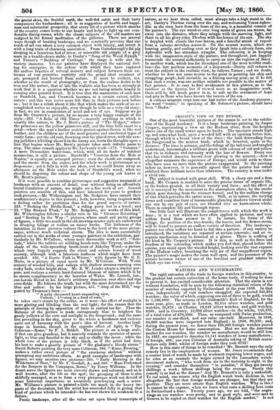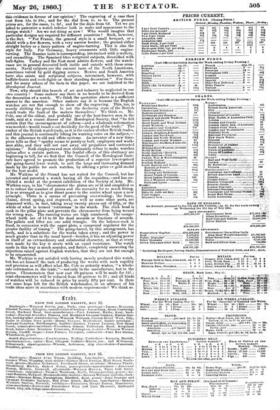WATCHES AND WATCIII&AKING.
The rapid extension of the. trade in foreign watches in this country, to the gradual but certain extinction of the home,trade, if nothing be done to prevent it,. has _excited considerable attention. That the alarm is not without foundation, will be seen by the following statistical return of the number of watches exported by Switzerland in,the year 1858. In that year, independently of vast numbers smuggled, she exported 346,894 watches • the value of which, supposing one out of three to be gold, would be 1,166,8001. The returns of the Goldsmith's Hall of England, for the same year, give, as ,made in London, 83,614 silver watches, and gold watches, 26,876 ; in -Chester, 13,648 silver watches, and gold watches, 8200; and in Coventry, 16,000 silver watches—in the whole, 146,332, of a total value of 670,4861. Thus, as compared with Swiss production, our number is one-third, and our value one-half. Moreover, in 1856, 90,000 watches were iniported into England ; in 1858, 99,329; tied, during the present year, no fewer than 100;000 foreign watches passed the Custom House for home consumption. Had we not the American market for our watches, the number we manufacture would be still less; In 1857, we exported to America 14,141 watches of home manufacture ; of foreign, 400; our own. Colonies of Australia taking of British manu- facture only 3082, whilst of foreiga make they took 6722! . How is this state of things to be remedied ? Mr. Bennett says the only remedy lies in the employment of women. Mr. Jones recommends that a coarser kind of watch be made by workmen requiring lower wages, and he cites as an example the wages earned by the Lancashire watch- movement makers, "who work from six in the morning to eight in the evening," and consider themselves " in paradise," if they get twenty shillings a week ; fifteen shillings being the average. Surely this remedy is as bad as the disease? And Mr. Bennett's is only a makeshift. To our mind, one reason why the English watch trade declines is, not altogether the fact that foreign watches are cheaper, but that they are prettier. They are more ornate than English watches. Why is this ? It cannot be the expense, when we learn what costa a shilling here costs in Switzerland a franc. Twenty years ago, we are told, "the engra- vings on our watches were pretty, and in good style, and were sent to Geneva to be copied on their watches for the English market." Is not
this evidence in favour of our opinion ? The engraving of a case then cost from 15s. to 258., and for the dial from 4s. to 68. The present prices are, for the cases, le. 6d., and for the dials from 6d. Yet we are asked to patronize a watch inferior both in make and appearance to the foreign watch ? Are we not-doing so now ? Who would imagine that particular designs are required for different countries ? Such, however, is the fact. " For France, the general style is a small bouquet, or a shield with a few flowers, with a very narrow border; the ground either straight barley or a faney pattern of engine-turning. This is also the style for Italy. For Germany, heavy ornaments with little engine- turning. The Russian taste is correspondihg, intermixed with jewellery, and enamelling. The Spaniard likes scriptural subjects, diversified with bull-fights. Turkey and the East most 'admire flowers, and the watch- cases are in general decorated both inside and outside with these orna- ments. Naval subjects are the current taste of the North Americans, sometimes varied by gold digging scenes. Mexico and South America have also saints and scriptural subjects, intermixed, however, with buffalo-hunts and cock-fights as their standing decoration." For these, and for many others of the facts in this paper, we are indebted to the Herologieal Journal.
Now, why should this branch of art and industry be neglected in our awn country ? Some makers say there is no benefit to be derived from the decoration of a watch. We think the quotation above is a sufficient answer to the assertion. Other makers say it is because the English watches are not flat enough to show off the engraving. This, too, is merely shifting the ground. Is not the declining state of the British watch trade the fanft of the makers themselves ? We think so. Mr. Cole one of the oldest, and, probably, one of the best-known men in the trade, said at a recent dinner of the Itorological Society, that "he felt certain that the encouragement of reform-and a wholesale reformation was needed-would result most decidedly for the good of the trade." The canker of the British watch trade, as it is the canker of other British trades, and this journal is continually lifting its warning voice on the subject,- is the adherence to old and effete, systems. An inventor of a new time- piece tells us that " apathy seems to paralyze both employers and work- men alike, and they will, not cast away old prejudices and contracted opinions." Both employers and men obstinately refuse to make watches unless after a certain pattern. The fearful effects of this obstinacy are beginning to tell, for we find that the Council of the Horological Insti- tute have agreed to promote the production of a superior lower-priced fiat going-barrel lever watch, to suit the large and increasing demand made by the public for such watches, by offering a prize cr gold medal for the best model.
Mr. Watkins of the Strand has not waited for the Council, but has invented and patented a watch having all the requisites,-and has ex- hibited a model at the present exhibition of the Society of Arts. Mr. Watkins says, in his " chronometer the plates are seid and simplified so as to reduce the number of pieces and the necessity for so much fitting. It is so arranged as to give direct power to the centre wheel upon a new principle. There is a means of preventing overwinding ; the fusee, chains, ditent spring, and stopwork, as well as some other parts, are dispensed with ; in fact, taking away twenty pieces out of fifty, or the whole of what is termed `rottenness' in the watch. The click head is sunk in the pillar plate and prevents the chronometer from being wound the wrong way. The running trains are high numbered. The escape- wheel teeth are of 15 to 30 for dead seconds or fractions of seconds. The pallets and lifter are one solid triangle. On the balance-cock is fixed, in connexion with the upper plate, a compound regulator for the greater facility of timing." The going-barrel, by this arrangement, has teeth, and is a substitute fur the works, taken away ; and the power is much greater than in tho usual barrel-besides, it has an adjusting power in itself of an extraordinary and substantial character, so that at every turn made by the key it meets with an equal resistance. The watch made in thia way is much sounder, and flatter, completely answering the objections raised against English watches, that they are not flat enough to be ornamented.
Mr. Watkins is not satisfied with having merely produced this watch, but has set himself the task of producing the works with such rapidity and precision as will effect what Mr.. Cole so ardently wishes, " a whole- sale reformation in the trade,"-not only in the manufacture, but in the prices. Chronometers that now cost ‘,60 guineas will be made for 341. ; semi-chronometers will be reduced from 30 guineas to 21 ; and all kinds of watches will be reduced in ,price by nearly fifty per cent. Is there not some hope left for the British watchmaker, in an advance of his trade ideas more in accordance with moddrn requirements ? We think so.



























 Previous page
Previous page